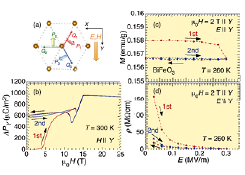Unveiled Multiferroic Properties in BiFeO3
Tokunaga Group
Recent extensive studies on multiferroic materials were motivated not only by the interest in basic science, but also by their possible application to magnetic memory devices writable by electric fields with low power consumption. Among various multiferroic materials, BiFeO3 is perhaps the most extensively studied because of its huge spontaneous electric polarization (PS) as well as high ordering temperatures. Our recent careful studies of magnetoelectric effects revealed existence of novel electric polarization (PT) normal to the PS that can be controlled by magnetic fields in a non-volatile way [1].

Fig. 1(a) Schematics of BiFeO3 within the ab-plane. Brown circles represent Fe ions. Thin and thick arrows show propagation vectors of the cycloidal spin order and transverse electric polarization, respectively. (b) Magnetic field dependence of electric polarization measured at 300 K for first and second field cycles. The prominent hysteresis below 10 T in the first field scan corresponds to the reorientation of the magnetoelectric domains. Electric field dependence of (c) magnetization and (d) resistance of BiFeO3 in the first and second field cycles.
The novel PT is found to couple with magnetic domains of the cycloidal spin order (Q-domains). Owing to the C3 symmetry of the crystal, there are three equivalent directions for the spin modulation vector. Thereby, the Q-domains are specified by the vectors Q1, Q2, and Q3 shown in Fig. 1(a). Here, each Q-domain contains PT normal to its Q-vector as illustrated in Fig. 1(a) as P1, P2, and P3. Application of high magnetic field can realize the single Q-domain state. The reorientation process appears as an irreversible change in the electric polarization below 10 T in the first magnetic field cycle as shown in Fig. 1(b).
As a counter effect of this phenomenon, we can expect control of the Q-domains by external electric fields. Such electric control of Q-domains is resolved through magnetization measurements as a function of electric field. In the reorientation process of the Q-domain in the first electric field scan, we observed irreversible change in magnetization as shown in Fig. 1(a) [2]. Simultaneous measurement of the resistance also shows irreversible change only in the first field scan: the resistance at a certain electric field becomes small after application of E = + 0.3 MV/m [Fig. 1(b)]. Interestingly, this low resistance state can be switched back to the high resistance one by applying E = – 0.3 MV/m. This switching between high and low resistance states, in other words the bipolar RRAM effects, appears repeatedly at least 20,000 cycles at room temperature [2].
These experimental results revealed the unveiled multiferroic properties in BiFeO3 will be useful for non-volatile memory devices writable by electric fields, readable simply by measuring their resistance, and stable against external fields at least up to 4 T.
References
- [1] M. Tokunaga et al., Nat. Commun. 6, 5878 (2015).
- [2] S. Kawachi et al., Appl. Phys. Lett. 108, 162903 (2016).
